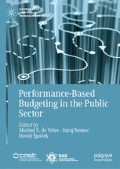Abstract
This case study focusses on performance monitoring of local government which is attracting greater attention from state agencies, regulators and the scholarly community. The chapter examines the case of New South Wales, Australia, which introduced performance monitoring for all councils in 2014 based on just seven financial ratios. This performance monitoring data was subsequently used to decide: (i) which councils would be forcibly amalgamated, (ii) which councils would gain access to cheaper finance, and (iii) the details of future improvement plans for councils. The first part of this chapter details the gaming which occurred as a result of the poor design of the 2014 performance monitoring framework whilst the second part explores solutions to the identified problems which formed part of a subsequent (council led project) in 2016 under the auspices of the Institute for Public Policy and Governance at the University of Technology Sydney.
Access this chapter
Tax calculation will be finalised at checkout
Purchases are for personal use only
Notes
- 1.
Whilst nominally a ‘voluntary’ process, councils were directed that they must fill in an amalgamation proposal if they failed to meet all seven metrics in addition to the ill-defined ‘adequate scale and capacity’ criteria.
- 2.
In intercensal periods the Australian Bureau of Statistics (ABS) merely estimates population size and these estimates have been shown to contain errors of up to 15.2% (Drew and Dollery 2014b).
- 3.
The exception was the ‘efficiency’ ratio assessed over five years.
- 4.
It should be noted that we are merely borrowing from the conceptual framework of the fraud literature and in no way are trying to imply that fraud—rather than gaming—occurred.
- 5.
Although there remains the unlikely possibility that the public service in NSW is largely dominated by knaves.
- 6.
An example of this is the report in the Sydney Morning Herald that provocatively stated: ‘Sydney’s roads are getting better even without being fixed… according to the city’s councils, which have recently wiped from their balance sheets a billion dollars of liabilities such as run-down old roads, often without spending a cent’ (Robertson and Buckingham-Jones 2015).
References
Bevan, Gwyn, and Christopher Hood. 2006. What’s Measured Is What Matters: Targets and Gaming in the English Public Health Care System. Public Administration 84 (3): 517–538. https://doi.org/10.1111/j.1467-9299.2006.00600.x.
De Bruijn, Hans. 2007. Managing Performance in the Public Sector. London: Routledge and Taylor & Francis.
Department of Local Government (DLG). 2003. Comparative Information on New South Wales Local Government Councils, 2002–2003. Sydney: Department of Local Government.
Drew, Joseph. 2017. Playing for Keeps: Local Government Distortion of Depreciation Accruals in Response to High-Stakes Public Policy-Making. Public Money & Management 38 (1): 57–64. https://doi.org/10.1080/09540962.2017.1389542.
Drew, Joseph, and Brian Dollery. 2014a. Estimating the Impact of the Proposed Greater Sydney Metropolitan Amalgamations on Municipal Financial Sustainability. Public Money & Management 34 (4): 281–288.
Drew, Joseph, and Brian Dollery. 2014b. Keeping It In-House—Households as an Alternative Proxy for Local Government Output. Australian Journal of Public Administration 73 (2): 235–246.
Drew, Joseph, and Brian Dollery. 2015a. Less Haste More Speed: The Fit for Future Reform Program in New South Wales Local Government. Australian Journal of Public Administration 75 (1): 78–88.
Drew, Joseph, and Brian Dollery. 2015b. Inconsistent Depreciation Practice and Public Policymaking: Local Government Reform in New South Wales. Australian Accounting Review 25 (1): 28–37.
Drew, Joseph, and Brian Dollery. 2015c. The State of Things—The Dynamic Efficiency of Australian States and Territories. Economic Papers 34 (3): 165–176.
Drew, Joseph, and Brian Dollery. 2016a. Summary Execution: The Impact of Alternative Summarization Strategies on Local Governments. Public Administration Quarterly 40 (4): 814–841.
Drew, Joseph, and Brian Dollery. 2016b. What’s in a Name? Assessing the Performance of Local Government Classification Systems. Local Government Studies 42 (2): 248–266.
Drew, Joseph, and Bligh Grant. 2017. Means, Motive and Opportunity: Distortion of Public Policy Making Performance Management Data. Australian Journal of Public Administration 75 (1): 237–250.
Drew, Joseph, Janine O’Flynn, and Bligh Grant. 2017. Performing What? Exploring and Expanding the Notion of Synecdoche in Performance Management Practice. Public Administration Quarterly 42: 395–424.
Le Grand, Julian. 2003. Motivation, Agency, and Public Policy: Of Knights & Knaves, Pawns & Queens. Oxford: Oxford University Press.
Le Grand, Julian. 2010. Knights and Knaves Return: Public Service Motivation and the Delivery of Public Services. International Public Management Journal 13 (1): 56–71.
Office of Local Government. 2015. Time Series Data. Sydney: Office of Local Government.
Rezaee, Zabihollah. 2005. Causes, Consequences, and Deterence of Financial Statement Fraud. Critical Perspectives on Accounting 16 (3): 277–298. https://doi.org/10.1016/s1045-2354(03)00072-8.
Robertson, James, and Sam Buckingham-Jones. 2015. Sydney Councils Shift $1 Billion Repair Bill with Accounting ‘Fiction’ in Fit for the Future Scramble. Sydney Morning Herald, 22 June 2015.
Walker, Richard M., George A. Boyne, and Gene A. Brewer. 2010. Public Management and Performance. Cambridge: Cambridge University Press.
Author information
Authors and Affiliations
Corresponding author
Editor information
Editors and Affiliations
Rights and permissions
Copyright information
© 2019 The Author(s)
About this chapter
Cite this chapter
Ryan, R., Drew, J. (2019). Performance Monitoring in New South Wales Australia. In: de Vries, M.S., Nemec, J., Špaček, D. (eds) Performance-Based Budgeting in the Public Sector. Governance and Public Management. Palgrave Macmillan, Cham. https://doi.org/10.1007/978-3-030-02077-4_3
Download citation
DOI: https://doi.org/10.1007/978-3-030-02077-4_3
Published:
Publisher Name: Palgrave Macmillan, Cham
Print ISBN: 978-3-030-02076-7
Online ISBN: 978-3-030-02077-4
eBook Packages: Political Science and International StudiesPolitical Science and International Studies (R0)

